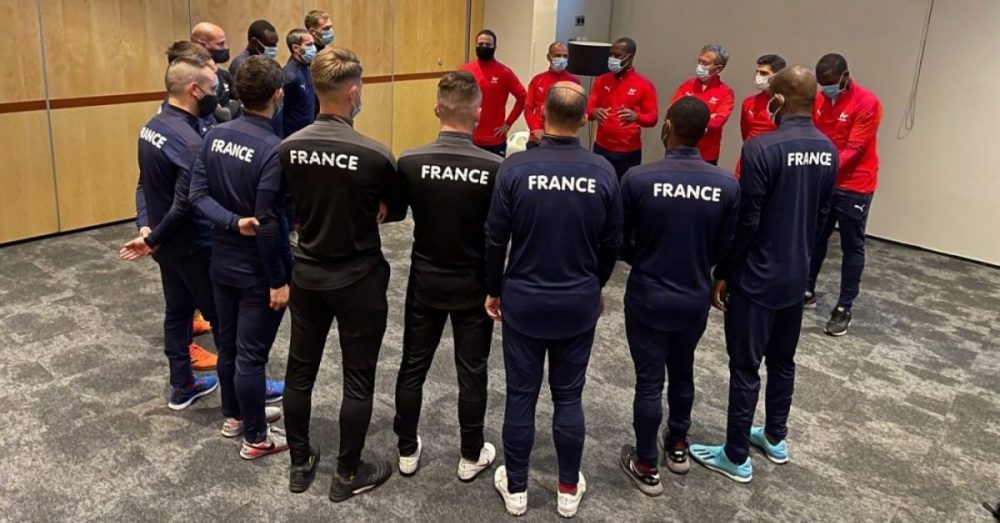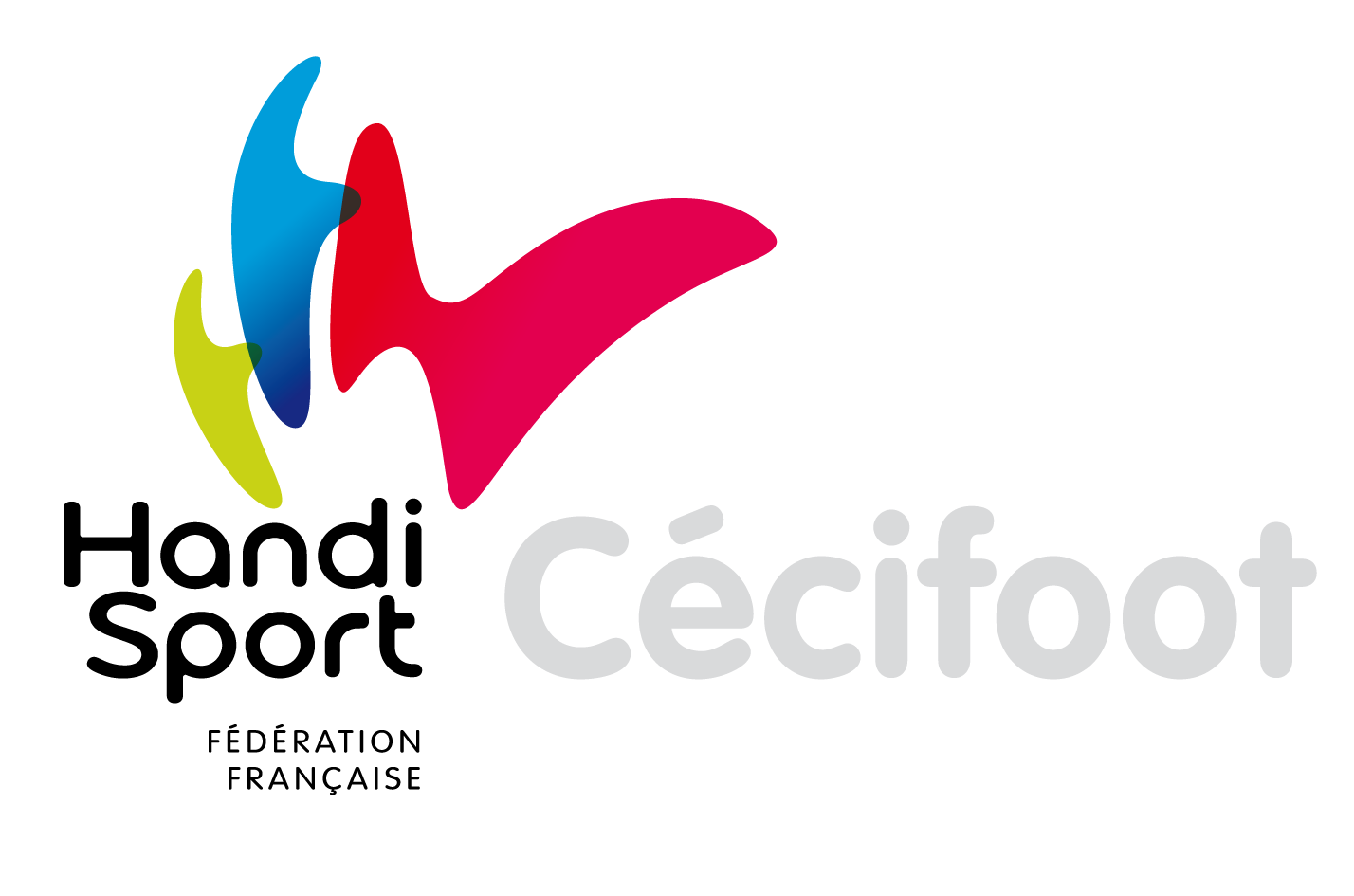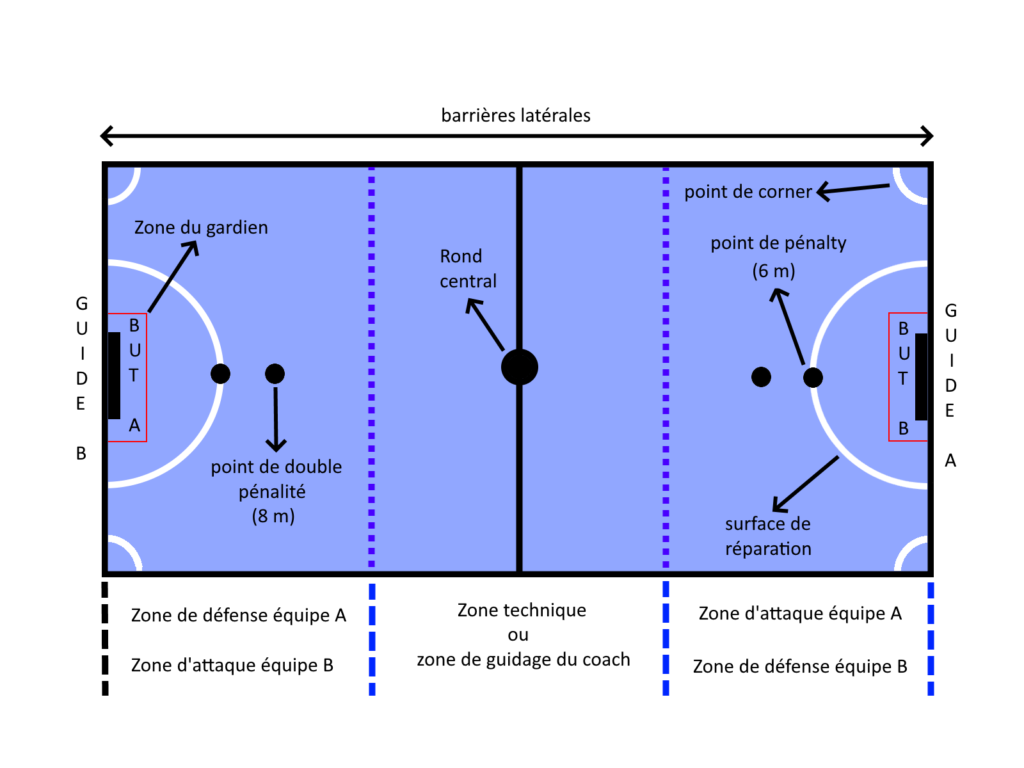|
Getting your Trinity Audio player ready...
|
A blind football match is similar to a “futsal” or “5-a-side soccer” match, but with a few special features. The two categories of blind football will be distinguished here because they do not have the same specificities.
In category B1 (blind players)
Two teams of five players will compete : four blind field players and one sighted goalkeeper. In addition to his traditional role, the goalkeeper will have to guide his defenders. In addition, there is a coach and for this category only, an offensive guide whose role is to guide the attackers. The field players have a eyeshade on their eyes so that each sportsman plays in the same conditions : equality between a completely blind player and the one who would have a visual rest.
The field
It has a rectangular shape with a width of 20 meters and a length of 40 meters. Barriers delimit it laterally along the touch line until about 1 meter after each goal line. The height of the barriers is between 1 meter and 1.20 meters. The field is ideally uncovered to provide better acoustics.
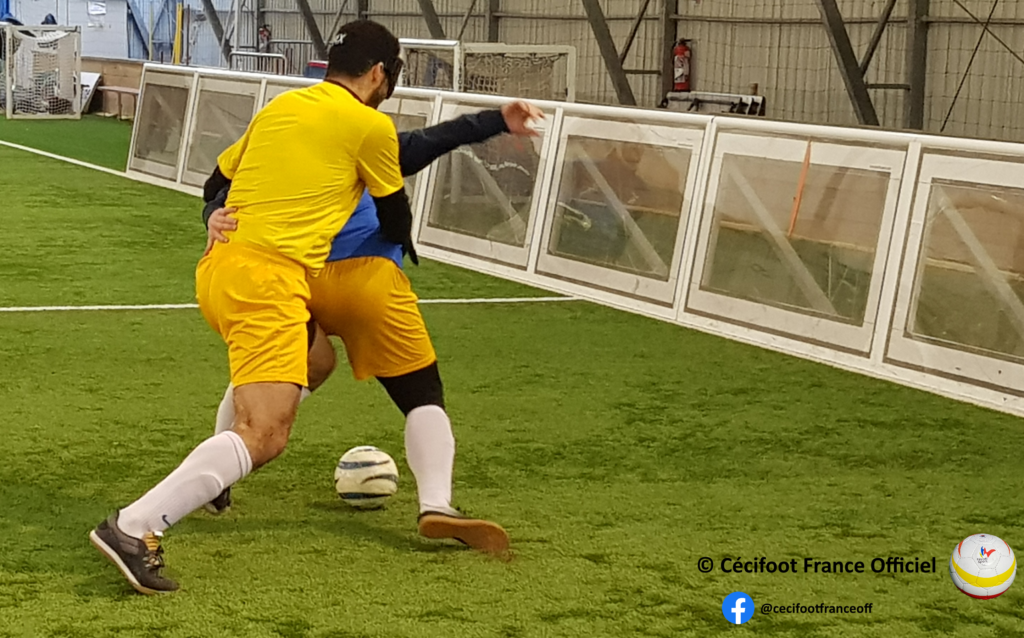
A blind football field is divided into three zones, delimited by a dotted line, parallel to the goal line, 12 meters from it, on each side:
- a defensive zone : between the team’s goal and the 12-meter line. It is in this zone and only in this zone that the sighted goalkeeper can guide his defenders
- a middle zone or technical zone : between the other two zones, including the center line. It is here that the team coach can give instructions to his players. And only in this zone.
- an attack zone : between the goal and the opponents’ 12-meter line. It is only from the limit of this zone that the guide, located behind the opponent’s cage, can direct his team’s attackers towards the goal.
Other areas are present on a blind football field :
- the goalkeeper’s zone : the goalkeeper may not leave it and may not have contact with the ball outside it. It starts laterally 1 meter from each post and extends 2 meters forward.
- the penalty area : it corresponds to an arc of a circle that passes through the penalty mark 6 meters from the goal line and whose center is located between the two posts. A penalty is awarded in case of a foul in this area.
Different points are materialized on the ground :
- the center circle : where the match starts
- the penalty point : where penalties are taken in the cases provided for in the regulations
- the double penalty point : located 8 meters from the goal line. A shot is taken from this point when 6 fouls have been committed by a team during the same half.
The playing surface must be smooth, without roughness, rather in cement or in natural or synthetic grass.
Blind football goals are similar to field hockey goals, measuring 3.66 meters from post to post and 2.14 meters from ground to crossbar.
Actors of the game
In B1 category, throughout the game, blind players receive audio guidance from players on and off the field.
- the coach : can give any kind of information to the players of his team as long as they are in the central zone of the field : between the defensive zone and the attacking zone. For example: position of the ball, ball won or lost by the team, position of the opponents, etc…
- the goalkeeper : he mainly gives sound information to his defenders to organize the best coverage of his goal. He can also guide any player in the defensive zone.
- the offensive guide : he is located behind the opponent’s goal. His role is to orientate the attackers by telling them by voice the location of the goal where they will have to shoot during the progression of a player with the ball. We generally hear data about distance, position in relation to the goal (left, right, axis) or the presence or absence of defenders. He can only guide in the attacking zone of his team.
The ball
Bells are placed inside so that the ball makes noise when it rolls on the ground. Thanks to the sounds made by the ball, the players know its location as soon as it is in play. By extension, the defenders also know the position of the ball carrier on the field.
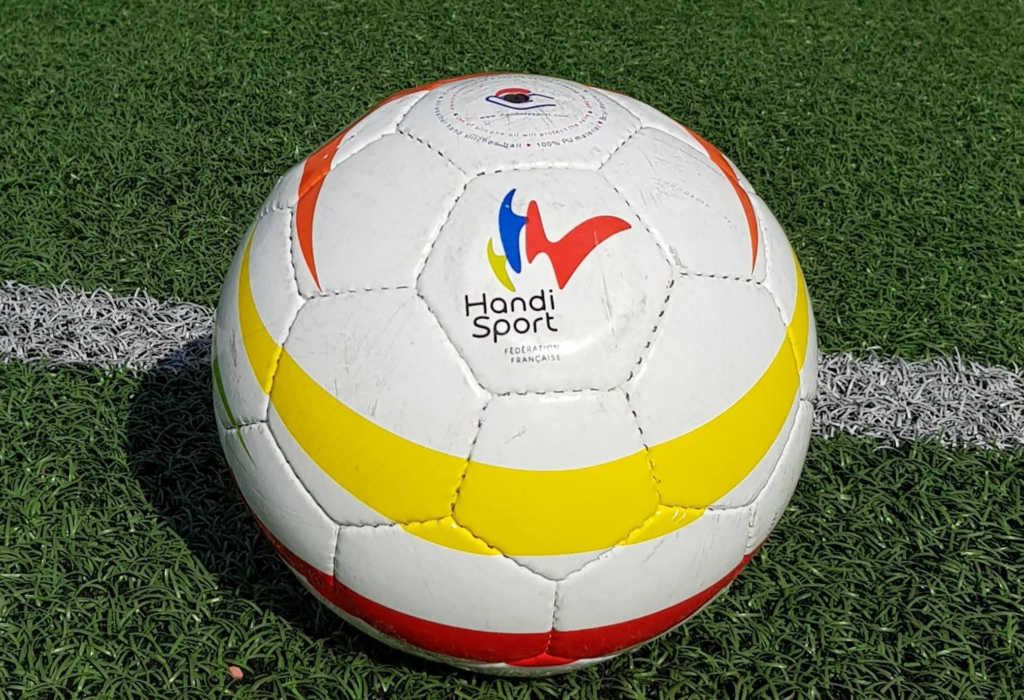
Listen to the sound produced by a moving ball :
The movement of the players on the field : the “voy” rule
This is the essential rule for the smooth running of a blind football match. “Voy” means “I’m going” in Spanish. Each player who is not in possession of the ball must signal his location by saying the word “voy” clearly and distinctly. It is thanks to all this sound informations that the ball carrier knows the position of his opponents.
The players of the same team also communicate with each other to organize their game phases. Teammates can therefore define codes between themselves by saying key words : “yes”, “pass”, “opposite”. An attacker can thus distinguish between a teammate who is unmarked and who calls for a pass, and a defender who says “voy”.
When a player has the ball, he can shout “GOT IT” to inform his teammates who recognize his voice.
The coach, guide or goalkeeper can also, in their respective guiding area, inform the players of who has the ball by yelling “LOST !” or “WON !” depending on whether their team regains control of the ball or not.
A B1 blind football match is therefore a large collection of sound information that a player must be able to sort, analyze and exploit, thus requiring great concentration. This is the reason why the public attending a match is usually asked to remain silent.
Duration of a match
In the French championship, a match is played in two periods of 25 minutes in continuous time. This means that a stoppage of play (such as a foul or goal clearance) does not stop the clock.
On the other hand, at the international level, two 20-minute periods are played in real time : the clock is stopped at each break in play. A match can therefore easily last up to 1h15.
In category B2/B3 (visually impaired players)
A game will be played between two teams of five players : four field players and a goalkeeper. Unlike the B1 category, the goalkeeper can be sighted or visually impaired, although most of the time the goalkeeper is still sighted.
There are two subcategories of players :
- a player classified as B2 has a maximum visual acuity of 1/20 and a maximum visual field of 5
- a B3 player has a visual acuity between 1/20 and 1/10 and a visual field between 5° and 20°
Each team must have at least two B2 players in a team of four field players. In the French championship, a specific band with a color per team, placed on the front, will allow to differentiate the participants of different sub-categories.
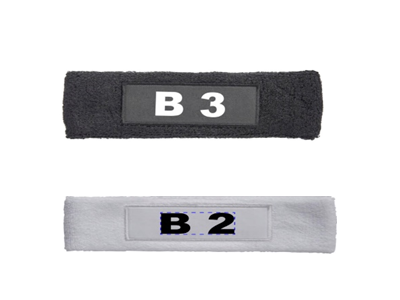
This rule will be applied starting with the 2020/2021 national season and will :
- visually help a player to find his way around (in addition to the distinctive jerseys of different colors per team)
- allow a spectator to identify the differences of classification between the players and thus better understand the functioning of the discipline
The field
The match takes place on a rectangular field 20 meters wide and 40 meters long. As in category B1, it is delimited on each side by side barriers.
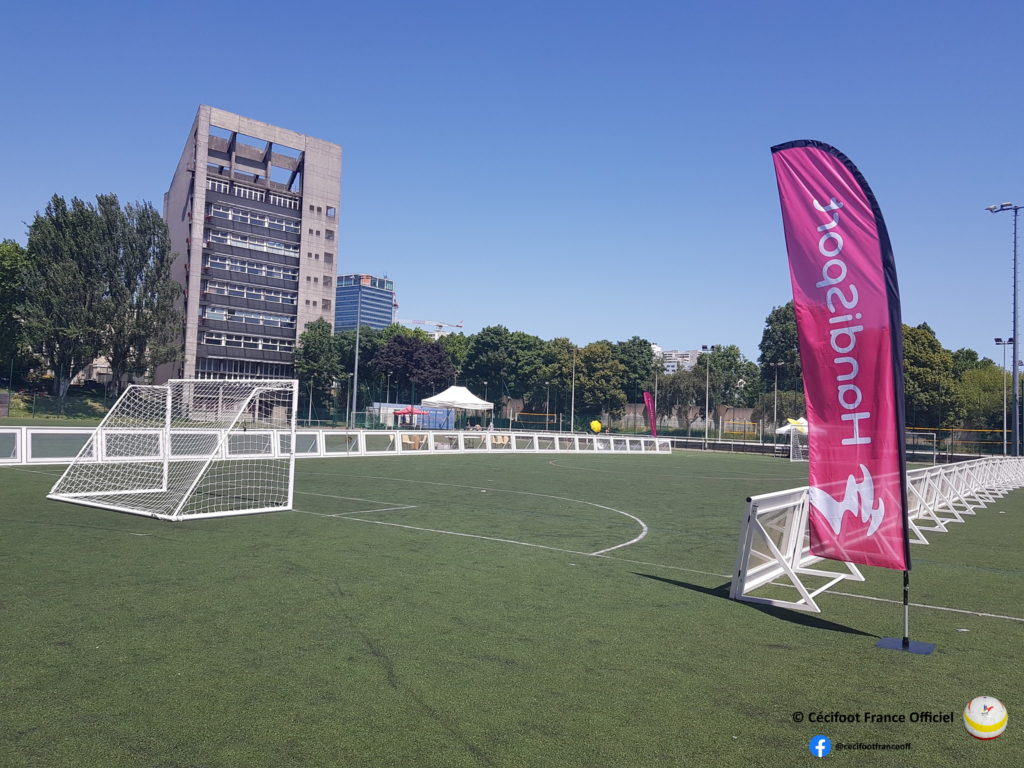
In B2/B3 category, there are no specific zones on the field as in B1. There is only the penalty area that the goalkeeper is not allowed to leave and/or interfere with the game outside of it. The goalkeeper’s area present in B1 does not exist.
Traditionally, and for practical reasons of organization, the B2/B3 competitions take place on “futsal” fields, therefore more indoors.
The ball
In the French championship, it is almost identical to that of category B1 ; that is to say that it contains bells allowing it to make noise when it is in movement. The sound device inside is simply lighter than in category B1. On the other hand, at the international level, B2/B3 competitions use “futsal” type balls with the only difference being that the color of the ball is clearly different from the ground. The players will thus perceive the ball visually better. France has chosen to use balls with bells for its national B2/B3 championship in order to allow access to severely visually impaired players.
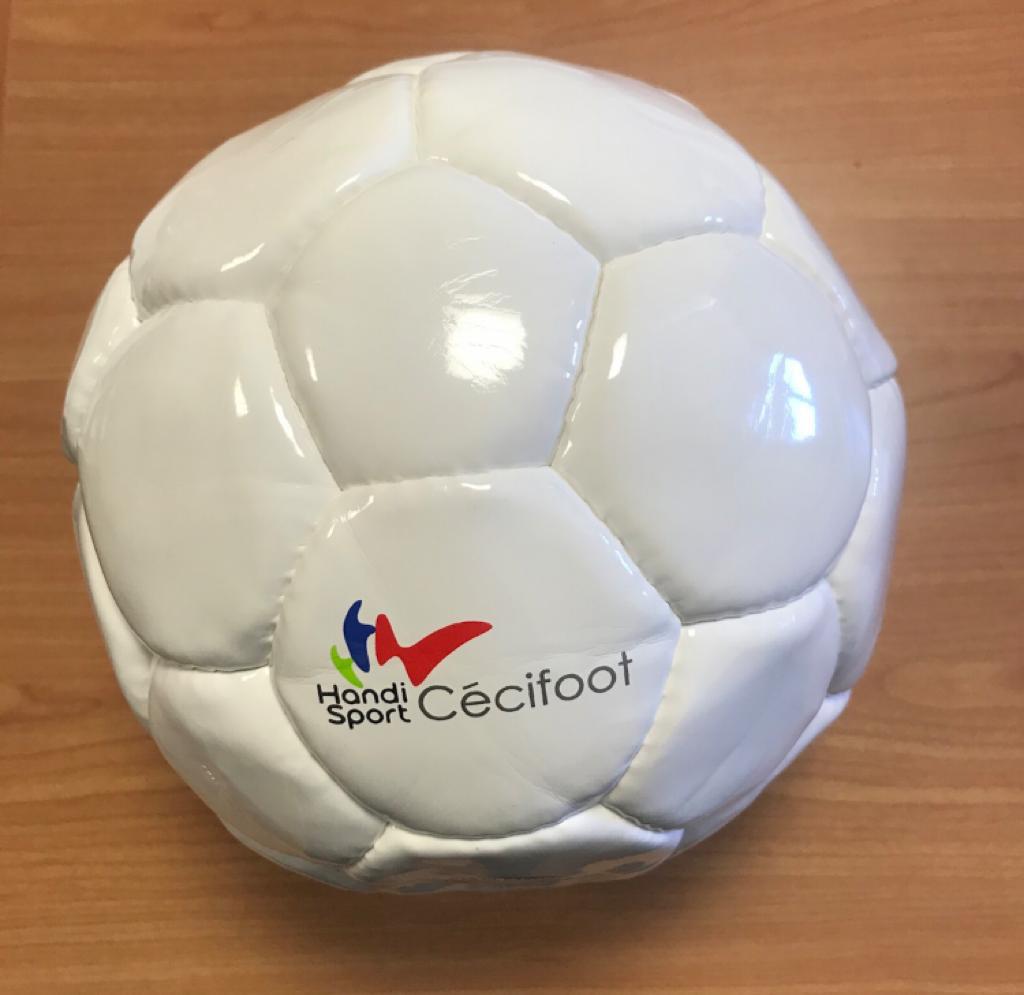
Duration of a match
A game is played in two periods of 20 minutes in effective time. This means that a stoppage of play (such as a foul or a goal) will stop the clock.
Retrouvez-nous également sur nos réseaux sociaux :Vous aimez cet article ? Aidez-nous à le faire connaître en le partageant :
